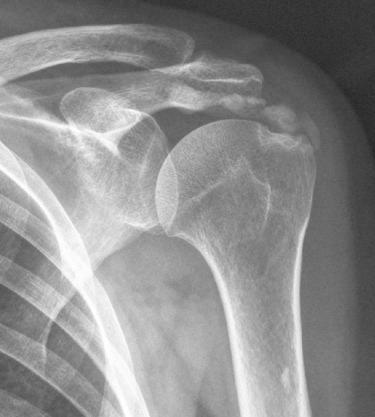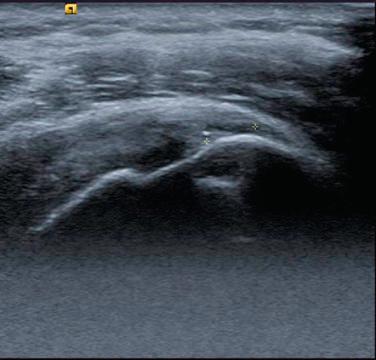Physical Address
304 North Cardinal St.
Dorchester Center, MA 02124
Rotator cuff calcific tendinopathy (RCCT) is a common cause of nontraumatic shoulder pain, characterized by calcium deposits in the substance of the tendon, first described by Painter in 1907. Calcific deposits can be found in up to 22% of patients during routine shoulder examination. A study from Louwerens et al. in 2015 found that in symptomatic patients with acute or chronic nontraumatic shoulder pain, the prevalence of calcific deposits in the rotator cuff was 42.5%. In most instances, the calcific deposits are located in the supraspinatus tendon (70%–87%), followed by the infraspinatus tendon (9%–20%) and the subscapularis tendon (4%–7%). Calcific tendinopathy of the subscapularis tendon is less common, and it may be the cause of secondary subcoracoid impingement. Women aged between 30 and 50 are the most frequently affected, and the pathology is bilateral in 10% of patients.
The pathogenesis is still not completely understood, and many theories have been developed. Codman first tried to explain the pathogenetic process of RCCT, proposing that the degeneration of rotator cuff tendons caused by overuse or aging is the first step that precedes calcification. Sandstrom proposed that degeneration of the tendon fibers, secondary to local ischemia, was the leading factor that induces the deposition of calcific deposits. More recently, Uhthoff and Loehr hypothesized that a favorable environment permits an active process of cell-mediated calcification, usually followed by spontaneous phagocytic resorption. Degenerative changes cannot be solely responsible because calcific tendinopathy has been reported in twin brothers and in children, which makes it difficult to fully explain these phenomena with a reactive degenerative theory.
The association between calcific tendinopathy and metabolic diseases, such as diabetes mellitus and thyroid disorders, has been pointed out, but the precise mechanism is still unknown. Patients with associated endocrine disorders present with earlier onset of symptoms, longer natural history, and undergo surgery more frequently compared with a control population. More than 30% of patients with insulin-dependent diabetes present with tendon calcification. A recent study demonstrated that thyroid hormone nuclear receptors are present on tenocytes, and that, in vitro, thyroid hormones enhance tenocyte growth and counteract apoptosis in healthy tenocytes isolated from tendons in a dose- and time-dependent manner. Hypothyroidism causes accumulation of glycosaminoglycans in the extracellular matrix (ECM), which may predispose patients to develop tendinopathy and tendon ruptures. However, the relationship between tendinopathy and metabolic disorders is still under investigation.
Most RCCT can be treated successfully conservatively, Nonsteroidal antiinflammatory drugs (NSAIDs) are widely prescribed to control pain, often before the radiographic diagnosis of calcific tendinopathy.
Shockwave therapy is widely used for the management of calcific tendinopathy. A recent systematic review showed good evidence of the benefit of high-dose focused extracorporeal shockwave therapy (F-ESWT) in calcific tendinopathy of the rotator cuff in reducing pain and improving shoulder function at 6-month follow-up.
Although most patients with calcific tendinopathy respond well to conservative management, approximately 10% of patients require surgical removal of the calcium deposits. Surgery is indicated in patients with severe, disabling symptoms that have persisted for more than 6 months, but there is no consensus regarding the optimal operative treatment. Needle lavage is a minimally invasive effective treatment for patients with acute painful RCCT. Shoulder arthroscopy is indicated in patients with large calcific deposits and long-standing symptoms.
RCCT can be asymptomatic. The prevalence of calcific deposits in the rotator cuff in asymptomatic patients is 7.8%. Women between the fourth and sixth decades of life have the highest chance of suffering from symptomatic RCCT.
When symptomatic, the main complaint is shoulder pain. The patient’s history will typically follow the three-stage natural history of the pathology:
Acute: characterized by severe pain, tenderness, and functional disabilities, generally for 1 to 6 weeks.
Chronic recurrent: common in the calcific stage of the pathology. It is characterized by waxing and waning pain. It may occur as such, without being preceded by an acute painful bout. Generally, it persists for 6 weeks to 6 months.
Persistent chronic pain: characterized by presence of a constant, dull pain, with no phases of remission or exacerbation, which occurs for more than 6 months.
Spontaneous resolution of symptoms. The pain and other symptoms are self-limited, and the natural history of the disease is for pain to improve over time.
A detailed history is of crucial importance. A medical history positive for diabetes or thyroid disease may increase suspicion for RCCT.
A thorough physical examination is demanded when evaluating a patient with shoulder pain. It includes:
Active and passive range of motion (ROM) of the shoulder. A restricted ROM and external rotation may be suspicious of adhesive capsulitis, which can be associated in patients with RCCT.
Manual muscle testing to assess for weakness that may be related to pain inhibition, a rotator cuff tear, or neurologic injury.
Special test for rotator cuff tears (external rotation lag sign [ERLS], Jobe test, drop arm test, lift-off test, belly-press or Napoleon test, internal rotation lag sign [IRLS], Speed test, palm-up test).
Provocative impingement tests (Hawkins impingement test, Neer sign test, and the Yocum test).
Sensation and reflexes should also be assessed if nerve damage is suspected.
Plain radiography: anteroposterior, internal, external rotation and outlet view plain films are usually sufficient to diagnose calcific tendinopathy of the shoulder, and they should be performed routinely ( Fig. 17A.1 ). Few patients may present with osteolysis of the greater tuberosity; this is usually associated with markedly lower clinical and functional outcomes both before and after surgical treatment.

Ultrasound (US): US is as sensitive a modality as plain radiography in identifying calcific deposits ( Fig. 17A.2 ).

US Doppler imaging: considered useful in predicting the evolution of calcific tendinopathy by some authors, but in reality few studies have assessed the association between US findings and clinical expression in routine practice. Le Goff et al. showed that positive power Doppler signal within the calcific deposits was strongly associated with pain. The combination of US and power Doppler scans provides useful information on the likelihood of the calcification being responsible for pain.
Magnetic resonance imaging (MRI): MRI evaluation is not routinely indicated, but it is useful in the evaluation of associated rotator cuff tears and calcific tendinopathy with osteolysis of the greater tuberosity.
Physical therapy, pendular movement, passive mobilizations of the shoulder, and gentle exercises
NSAIDs
Cimetidine
Corticosteroid injections
Therapeutic US
Extracorporeal shockwave therapy (ESWT)
Needle lavage technique
Shoulder arthroscopy
Severe disabling symptoms, which have persisted for more than 6 months.
Pain and functional limitations after conservative management (approximately 10% of patients).
The patient is sitting in a chair.
The affected shoulder is slightly internally rotated and the forearm is positioned behind the patient’s back.
The affected shoulder is prepared with antiseptic (2% chlorhexidine gluconate) and sterile drapes.
The procedure is performed under local anesthesia with 10 mL of 2% mepivacaine.
During the preliminary ultrasound scan, the position of the shoulder that will make the route to the calcific deposits most accessible is established.
Internal rotation of the affected shoulder increases the pressure inside the tendon and facilitates the infiltration of fluid.
At the beginning of the procedure, the calcific deposit should be punctured only to introduce the needles to maintain the integrity of capsule.
The use of warm saline as the injected fluid seems to help dissolve the calcific deposits and improve results.
If the calcification is hard, or the drainage of fluid is obstructed by very thick material, an 18G needle can be used.
Once the aspirated fluid is clear, or if no cloudy fluid could be removed, the deposit is needled repeatedly in an attempt to break up the remaining calcium deposit.
The arm position is a little uncomfortable for the patient, and it must be held throughout the procedure, approximately 30 minutes.
Few minor complications have been reported in the literature, with an overall complication rate of 10%. The most common complications are bursitis (7%), mild vasovagal reactions (2%), frozen shoulders (0.2%), and tenosynovitis of the long head of the biceps (0.1%).
A complete rotator cuff tendon tear could ensue after the US-PICT, because of the calcific deposit, and it could be the cause of persistent pain after the procedure. In this case, arthroscopic tendon repair is indicated.
2% chlorhexidine gluconate and a sterile drape
18G and 20G needles
10 mL of 2% mepivacaine
5 mL triamcinolone
Sterile physiologic warm saline solution
Various syringes
An ultrasound scan is performed first to locate calcific deposit. The area of the deposit can be marked with a surgical skin marker.
The surgical field is prepared in the usual sterile fashion.
First the needle is inserted with the syringe containing 10 mL of 2% mepivacaine and the ultrasound probe is placed on the path to be followed. The local anesthetic is injected into the subacromial space.
A 20G needle is inserted into the calcific deposit. The needle is introduced in-plane with the ultrasound beam, allowing visualization of the needle throughout its path to the calcium deposit.
A second 20G needle is introduced to aspirate the introduced fluid.
Once inside the calcium deposit, a small quantity of warm saline solution is injected into the calcific deposit. A cloudy fluid containing calcium usually comes out from the second needle. The procedure is repeated until the aspirated fluid is clear and the calcium deposit appears smaller on ultrasound images.
Once the lavage is completed, the second needle is removed, while the first needle is either drawn back into the subacromial space. Two milliliters of triamcinolone are administered to prevent subsequent bursitis.
A surgical dressing is applied.
The patient is advised to continue normal daily activities, avoiding overloading and sport activities involving the upper extremities during the first weeks after the treatment. Ice and oral analgesics are prescribed for the first 48–72 hours after the procedure.
A physiotherapy program consisting of pendular exercises, stretching, and gradual strengthening of the rotator cuff muscle is indicated for the first 4–6 weeks.
The patient is positioned in a standard beach chair position.
The upper limb is prepared and draped in the usual sterile fashion.
Residual tendon tears larger than 10 mm should be repaired.
Suture of the rotator cuff tears allows for early rehabilitation.
Whether it is necessary to remove all the calcium deposits and suture the tendon is still a point of contention in the literature. Some authors suggest that a minimal tendon debridement is sufficient to decrease the intratendinous pressure and minimize tendon damage. This is thought to promote progressive resorption of calcifications and the natural healing process of the tendon with resolution of symptoms. On the other hand, other authors have reported that complete removal of the deposits was associated with better outcomes than partial removal.
Suture of the residual tendon lesions after removal of the deposits is another debated topic. Residual tendon tears larger than 10 mm should be repaired. About 10% of patients treated surgically still reported pain related to a rotator cuff tear.
Become a Clinical Tree membership for Full access and enjoy Unlimited articles
If you are a member. Log in here